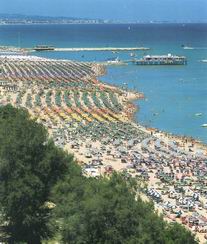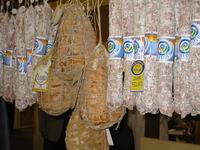 |
Pesaro-Urbino Travel Guide |
| Pesaro-Urbino district is wetting by the Adriatic sea: it is note for its "maioliche", the parks, the castles and its artistc treasures as well as adequate receptive structures and amusements for the seaside, religious, "green" and enogastronomic tourism. |
| Related images (30) |
|
SEASIDE RESORTS: The wide selection of paths for those who love trekking and who, complete with backpack, can cross this part of the province entirely on foot, meeting squirrels, deer, foxes and many of the other animals that populate these woods. Here and there, small corners of paradise appear as if forming a living picture: from the woods of Tecchie, with its crystal clear waterfall, to the mountain streams of monte Catria and Nerone. And for those looking for a more educational and challenging itinerary, there is a detailed Spring and Summer calendar of excursions with a guide and overnight stops at mountain refuges. On the Apennine ridge instead, stands the park of Sasso Simone e Simoncello, where centuries-old pine, oak and spruce trees lead up to the ruins of medieval fortifications. The park authority provides information and advice on how to enjoy this uncontaminated corner to the full, which leads into Val Marecchia where the beech woods provide a hiding place for churches and castles, real jewels of history and architecture. The walls of a number of rocky outcrops provide the opportunity for mountain climbing, while only eagles dare in the Furlo gorge nature reserve, where there are equipped family picnic areas and canoe hiring to explore the crystal clear waters of the river Candigliano. In Urbania, Palazzo Ducale (the Ducal Palace) houses the Biblioteca storica (Historical Library), the Museum and Pinacoteca (Art Gallery). Pennabilli has its Museo Diocesano (Diocesan Museum). In Apecchio, the Fossil Museum and in Cagli, the church of St. Domenico and its frescoes by Giovanni Santi, father of Raphael. The church of St. Maria d'Antico in Maiolo houses the Madonna delle Grazie by Luca della Robbia. The Castle at Sassocorvaro had a very important historical function, in that many of the outstanding Italian works of art were hidden and preserved here by Giuseppe Rotondi during the Second World War. Piandimeleto is the location of the “Castello dei conti Oliva”, while in Carpegna, at the foot of the mountain of the same name, stands the monumental Palazzo dei Principi (Princes’ Palace). Other important fortifications designed by Francesco di Giorgio Martini can be found at Montecerignone and Sant'Agata Feltria. Along the route of the river Metauro stand the three Corti Ducali (Ducal Courts) of Fossombrone, the Palazzo Ducale (Ducal Palace) and the Barco of Urbania, the latter being the hunting lodge of the Montefeltro family, and the Municipal building and tower at Sant'Angelo in Vado. High up the river Candigliano, the Castle of the Brancaleoni family overlooks the small hamlet of Piobbico. The solitary castle of Frontone stands on the slopes of monte Catria looking down on its hamlet. A meeting place of faith and history is the thousand-year old Eremo di Fonte Avellana. The sanctuary, which stands at the foot of monte Catria, was founded by San Pierdamiani and where the poet Dante was once a guest. Other ancient centres of devotion include the Francescan sanctuary of the Beato Sante at Mombaroccio, the sanctuary of the Madonna del Faggio at Carpegna, the image of the Madonna delle Lacrime at Pennabilli, the Crucifix by Giotto at Talamello, the temple of the Madonna del Sasso, near Pergola, the church of the Madonna del Pelingo, between Furlo and Acqualagna, the Santuario del Crocifisso at Casteldimezzo, the Cristo Morto in the Oratorio della Grotta at Urbino, the Santuario della Madonna delle Grazie in Pesaro, and the Santuario della Madonna del Ponte Metauro in Fano. The art of butchering pork, the appeal of “casciotta” (a soft cheese produced in central Italy) and the Sliced Steak of the Montefeltro area Descending the hills, to Montelabbate, the traveller can taste the exquisite local peaches, then continuing on the Strada Statale Urbinate in the direction of Carpegna, into the Montefeltro region, we reach Sassocorvaro. This area is replete with taste tempting flavours: high quality, skilfully aged meats, guaranteed to be from local Marche pastures, naturally leavened bread from Mercatello sul Metauro, and much, much more. Salamis, dried sausages, ham and inimitable cured pork loins are found in the shops along the road that goes from S. Domenico to Casinina. Ricotta and fresh cheeses of extraordinary quality can be found in the Madonna del Mozzicone area, but the pecorino cheeses from nearby Tavoleto are also worth trying and delicious cuts of lamb are available in the S. Donato Taviglione area. Continuing along the main road of the valley, we come upon Lunano where the Chestnut Festival is celebrated each Autumn; further along, we find Belforte with its refined honeys and a vast assortment of rare fruits: wild mountain cherries, various types of wild pears – lunghina, porcinella, rossina, volpina and sorbo. Here there is a crossroads: to the left, we can go truffle hunting in S. Angelo in Vado, known for the excellent valuable white truffle and for its “historical” vinsanto which can be tasted in the wine cellars in the centre of town; to the right, up to S. Sisto, known for its hazlenuts and mushrooms which are celebrated at a regional exhibition each Autumn. This archipelago of flavours is centred around D.O.P. products (products of Protected Origin) like the Casciotta di Urbino, the delicate, tempting cheese which, according to tradition, Michelangelo Buonarroti had sent to him in Rome while he was working on the decoration of the Sistine Chapel. Instead, nearby Isola del Piano is known for a wide range of organic products, from pasta to legumes, and even meat. Vernaccia, sour cherry wine and emmer, the grain of the Pharaohs Setting off from Marotta in the direction of Pergola on the Strada Statale Cesanense 424, after 25 kilometres we come to S. Lorenzo in Campo, the emmer capital. For here, in the village of Monterosso, the species “triticum dicoccum” – the emmer that the Egyptian Pharaohs were already using seven thousand years before Christ - was rediscovered and patented (the only such patent in the world). Then, continuing on the Strada Statale Cesanense, we come to Pergola. Here two wines are produced: the delicious sour cherry wine with a rich, sweet and harmonious flavour, the perfect accompaniment to chocolate sweets and to the local ring shaped cake; and the historical local red Vernaccia, a rare wine with intense floral aromas and a persistent wild berry aftertaste. If we continue up the valley for another 13 kilometres, we come to Serra S. Abbondio, known for the mills in which superior quality corn flour is still ground; in nearby Cantiano, the famous Chiaserna bread is produced. | |
 |
Search other Guides |
Related subjects
| Hotels in Pesaro (70) |
| Hotels in Urbino (16) |
| Tourist Home (2) |
| Golf (2) |
| Outlet and firm shops (19) |
| Residence (2) |
| Bathing establishments (61) |
| SPAs (4) |

 Munch: The Scream Within
Munch: The Scream WithinOne of the year’s most eagerly awaited exhibitions to open its doors on 14 September 2024: Edvard Munch is back in Milan with a major retrospective after a 40-year absence.
 In the garden
In the gardenThe initiative, which is scheduled to run from June 26th to September 13th, 2020, is inaugurating a temporary space for art in Corso Matteotti 5, in Milan, in the very heart of the city.
 Perugia Travel Guide
Perugia Travel GuidePerugia is the chief town of Umbria. This beautiful town is sited on a hill in the middle of a verdant country. His central square is considered one of the most beautiful squares of Italy and history, traditions, art and nature make a unique ensemble in this town as in the whole



 Visiting this part of the Adriatic means enjoying the spectacle of two of the very few headlands on the entire coastline, San Bartolo and Ardizio, taking advantage of the tranquillity of small isolated coves or experiencing the more frequented yet just as inviting sandy beaches. Forty kilometres of soft sand stretching from Gabicce to Marotta, with an abundance of hotels, updated and reclassified over the years, and numerous campsites between Pesaro and Fano, where the beach is even wider and where the rocky shore creates safe havens for children, country houses and holiday farms for those who prefer to enjoy the sea while immersed in the green of the countryside. To the north and Romagna lies the more popular resort of Gabicce Mare, where the splendours of the “Riviera” of the sixties still survives.
Visiting this part of the Adriatic means enjoying the spectacle of two of the very few headlands on the entire coastline, San Bartolo and Ardizio, taking advantage of the tranquillity of small isolated coves or experiencing the more frequented yet just as inviting sandy beaches. Forty kilometres of soft sand stretching from Gabicce to Marotta, with an abundance of hotels, updated and reclassified over the years, and numerous campsites between Pesaro and Fano, where the beach is even wider and where the rocky shore creates safe havens for children, country houses and holiday farms for those who prefer to enjoy the sea while immersed in the green of the countryside. To the north and Romagna lies the more popular resort of Gabicce Mare, where the splendours of the “Riviera” of the sixties still survives..jpg)

 The Romans, whose centurions ate this grain before going into battle because it was considered a good omen, brought spelt to the Mediterranean area. Moreover, the qualities of this grain speak for themselves: low in calories, rich in calcium with ten times the fibre of durum wheat and antioxidant properties. And what is the perfect match for emmer? The well-known Suasa onions, with their mild, sweet flavour. S.Lorenzo in Campo is also home to the first “farroteca” (shop dedicated to emmer) where emmer can be tasted in numerous ways; in town shops excellent honey with valued organoleptic qualities can be found, for example sunflower and alfalfa honey, or organically prepared honey. In the surrounding areas fine quality legumes are organically grown – beans, chickpeas and grass peas.
The Romans, whose centurions ate this grain before going into battle because it was considered a good omen, brought spelt to the Mediterranean area. Moreover, the qualities of this grain speak for themselves: low in calories, rich in calcium with ten times the fibre of durum wheat and antioxidant properties. And what is the perfect match for emmer? The well-known Suasa onions, with their mild, sweet flavour. S.Lorenzo in Campo is also home to the first “farroteca” (shop dedicated to emmer) where emmer can be tasted in numerous ways; in town shops excellent honey with valued organoleptic qualities can be found, for example sunflower and alfalfa honey, or organically prepared honey. In the surrounding areas fine quality legumes are organically grown – beans, chickpeas and grass peas.